gestion des zones humides favorables à la tortue cistude d ... - Cen-LR
gestion des zones humides favorables à la tortue cistude d ... - Cen-LR
gestion des zones humides favorables à la tortue cistude d ... - Cen-LR
You also want an ePaper? Increase the reach of your titles
YUMPU automatically turns print PDFs into web optimized ePapers that Google loves.
SOMMAIRE<br />
A. CONTEXTE DE L’ÉTUDE .................................................................................................................. 1<br />
I. L’ÉROSION DE LA BIODIVERSITÉ ET L’IMPORTANCE DES ZONES HUMIDES................................................ 1<br />
II. BIODIVERSITÉ ET POLITIQUE EUROPÉENNE ............................................................................................ 1<br />
III. UNE ESPÈCE MENACÉE : LA CISTUDE D’EUROPE.................................................................................... 2<br />
IV. STATUT RÉGLEMENTAIRE DE LA CISTUDE D’EUROPE ET GESTION CONSERVATOIRE................................. 3<br />
V. CONSERVATOIRE DES ESPACES NATURELS DU LANGUEDOC-ROUSSILLON (CEN L-R) ............................ 4<br />
VI. UN PROGRAMME RÉGIONAL DE CONSERVATION DE LA CISTUDE D’EUROPE ............................................ 4<br />
B. MATÉRIEL ET MÉTHODES .............................................................................................................. 6<br />
I. ETUDE ET GESTION DE ZONE HUMIDE : L’ETANG DE L’OR (34)............................................................... 6<br />
1. Objectifs et présentation du site ...................................................................................................... 6<br />
2. Bi<strong>la</strong>n foncier................................................................................................................................... 6<br />
3. Phase préparatoire du terrain......................................................................................................... 6<br />
4. Protocole de piégeage par Capture-Marquage-Recapture (CMR).................................................... 7<br />
5. Protocole d’étude diagnostic <strong>des</strong> sites de ponte potentiels ............................................................... 8<br />
II. ACCOMPAGNEMENT À LA COORDINATION DU PROJET ............................................................................ 9<br />
1. Financements ............................................................................................................................... 10<br />
2. Communication en réseau............................................................................................................. 10<br />
3. Sensibilisation .............................................................................................................................. 10<br />
C. RÉSULTATS ....................................................................................................................................... 11<br />
I. ETUDE ET GESTION DE ZONES HUMIDES............................................................................................... 11<br />
1. Bi<strong>la</strong>n foncier................................................................................................................................. 11<br />
2. Piégeages..................................................................................................................................... 11<br />
3. Capture expérimentale de Tortues à tempes rouge dite de Floride ................................................. 13<br />
4. Sites de ponte................................................................................................................................ 13<br />
II. DOSSIER DE RÉINTRODUCTION............................................................................................................ 13<br />
1. Démarche employée...................................................................................................................... 13<br />
2. Stratégie retenue........................................................................................................................... 14<br />
a. Phase de translocation.............................................................................................................................. 14<br />
b. Phase de suivi par télémétrie.................................................................................................................... 14<br />
c. Phase d’élevage....................................................................................................................................... 14<br />
3. Budget prévisionnel ...................................................................................................................... 14<br />
4. Avenir du dossier.......................................................................................................................... 15<br />
III. COMMUNICATION, INFORMATION ET SENSIBILISATION........................................................................ 15<br />
1. Outils de diffusion d’information : ................................................................................................ 15<br />
a. La Lettre du Groupe Cistude : public « expert »........................................................................................ 15<br />
b. Milieu sco<strong>la</strong>ire ........................................................................................................................................ 16<br />
c. Sensibilisation <strong>des</strong> collectivités territoriales.............................................................................................. 16<br />
d. Communication auprès <strong>des</strong> partenaires..................................................................................................... 17<br />
e. Information « tout-public » ...................................................................................................................... 17<br />
2. Sensibilisation du monde de <strong>la</strong> pêche ............................................................................................ 17<br />
a. Pêche de loisir : événementiels................................................................................................................. 17<br />
b. Rencontre de partenaires.......................................................................................................................... 18<br />
c. Pêche professionnelle et agents assermentés............................................................................................. 18<br />
D. DISCUSSION ...................................................................................................................................... 19<br />
I. ANALYSE DU TRAVAIL EFFECTUÉ ....................................................................................................... 19<br />
II. ANALYSE DES RÉSULTATS DE L’ÉTUDE DE POPULATION....................................................................... 19<br />
1. Difficultés et limites...................................................................................................................... 19<br />
2. Traits démographiques ................................................................................................................. 20<br />
3. Viabilité de <strong>la</strong> popu<strong>la</strong>tion.............................................................................................................. 21<br />
4. Mesures de <strong>gestion</strong> ....................................................................................................................... 21<br />
5. Une mesure de <strong>gestion</strong> complémentaire : <strong>la</strong> réintroduction............................................................ 22<br />
E. CONCLUSION.................................................................................................................................... 24<br />
Crédits photographiques : CEN L-R, Thomas Bennaïm (T.B), Thomas Gendre (T.G), Simon Woodsworth (S.W), Sonia Zecchini (S.Z)




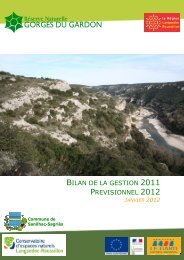
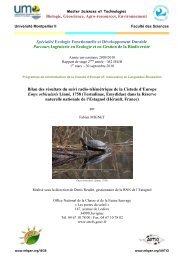
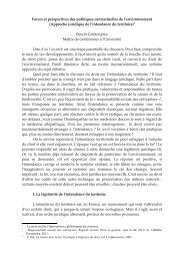
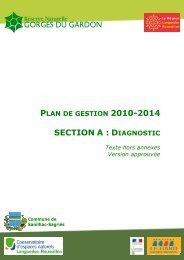

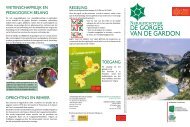
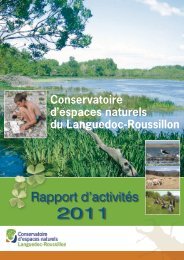
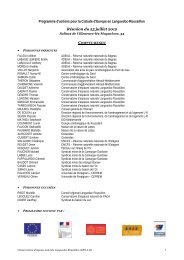
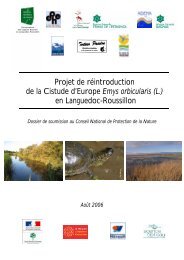
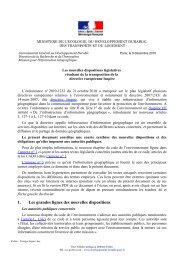
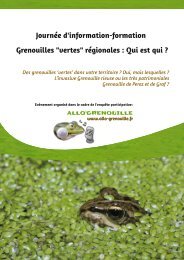
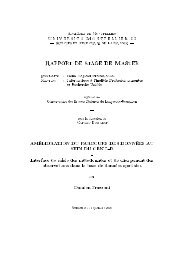
![Fiche de reconnaissance et contact pour le signalement [1,7Mo]](https://img.yumpu.com/28720302/1/182x260/fiche-de-reconnaissance-et-contact-pour-le-signalement-17mo.jpg?quality=85)